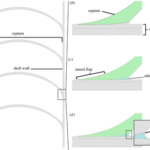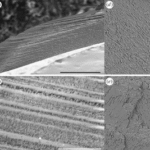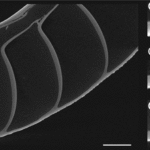paper, The role of mural mechanics on cephalopod palaeoecology
Cephalopods transformed the molluscan shell into a buoyancy device that must be strong enough to resist external water pressure. Historically, unique features of the shell have been interpreted on the basis that the strength of the shell presents a hard limit on maximum habitat depth. One such feature is the mural flap, which is a semi-prismatic layer deposited on the inner surface of some coleoid septa that has been suggested to strengthen the shell and permit colonization of deeper waters. We test this hypothesis by constructing finite-element models that show how mural modifications affect the response of the shell to hydrostatic pressure. The mural flaps are found to have no notable structural function. Another mural modification discovered here is the adapical ridge flap that initially seemed to have a potential function in shifting peak stress away from the attachment site of the septum; however, the irregular distribution of this feature casts any functional interpretation in doubt. Ecological separation of belemnites and decabrachians is likely not mediated by the presence/absence of mural flaps. This work illustrates a potential caveat that not all unique septal features formed in response to increasing hydrostatic pressure and deeper habitats. This paper presents a good opportunity for research into how cephalopods molluscan shells are strong enough to resist intense water pressure.
Learn about our two Decals!
 Click here to find out more about our Fall Bioinspired Design Decal and our Spring Bioinspired Design in Action Decal – ALL MAJORS are welcome.
Click here to find out more about our Fall Bioinspired Design Decal and our Spring Bioinspired Design in Action Decal – ALL MAJORS are welcome.Berkeley BioDesign Community
 Click here to learn about the BioD: Bio-Inspired Design @ Berkeley student organization or here to signup for more info.
Click here to learn about the BioD: Bio-Inspired Design @ Berkeley student organization or here to signup for more info.Search
Student Login






I imagine that the neurological circuits underlying these processes are governed by both 2d spacing maps with their brains as…
to reduce the impact of car accidents, it may be possible to study the force diverting physics of cockroaches to…
you see this type of head-bobbing stability in many avian creatures related to pigeons like chickens. the head ability to…
not like they taught horses how to run! this is an example of convergent evolution where both sea creatures and…
The brain functions in a similar way with neuronal connections. our brains are able to utilize the multiplicity of connections…